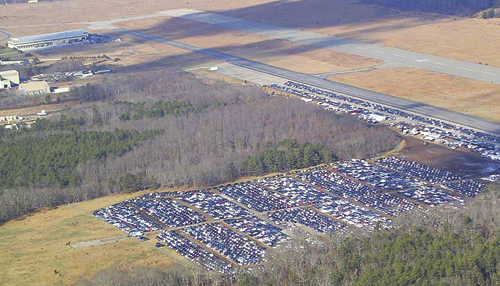Experts: ‘Sandy cars’ pose no threat

For weeks, environmental activists have pressed authorities to remove thousands of cars damaged by superstorm Sandy from the Enterprise Park at Calverton, saying the stored cars pose a pollution hazard because leaking fluids could seep into groundwater.
But local environmental and automotive experts say there’s nothing to worry about.
Mechanics and environmental consultants interviewed by the News-Review all agreed salt water from Sandy alone would not have caused those cars to rust to the point of leaking fluids.
“I certainly don’t believe the corrosive nature of salt water is so aggressive that it’s going to go through a gas tank in a few months,” said Mark Miller, owner of environmental services company Miller Environmental Group. “If you drive around in the wintertime you’re probably exposing the underbody of the car to as much, if not more, salt [than Sandy’s surge].”
Peter Ryan, a mechanic at Flanders Automotive, said that the very soonest cars might corrode to the point of leakage would be six months after initial exposure to salt water. But it would take the cars currently stored at EPCAL even longer to reach that point, he said.
“[Corrosion] could happen pretty quickly if the car is being used, but these cars are not,” he said. “Since these cars are just sitting there these cars are going to corrode a lot slower.”
Some mechanics polled said it might even take years for saltwater corrosion to cause battery fluid, gas or oil to leak. Other automotive professionals said the only way a flooded car would start leaking was if it had already been damaged before the storm.
A vehicle that sustained punctures from debris would also leak, said Harvey Bagshaw, owner of Starlite Auto Body in Mattituck.
“But it would leak out before the car even got [to EPCAL],” Mr. Bagshaw said. “I don’t see the problem.”
He added that any leaks from cars at EPCAL at this point would be “negligible.”
IAA, the auction company renting the tarmac space from Riverhead Town, has said that individual cars stored at EPCAL remain there an average of 45 to 60 days.
Last month, the New York State Department of Environmental Conservation did order cars parked on private grasslands at EPCAL to be removed.
But that enforcement action was carried out because the trucks loading and unloading the damaged cars threatened to crush the habitats of endangered salamanders in the area, not because of potential fluid leaks.
A DEC spokesperson said the cars on that private property are now being removed.
The operation on Riverhead Town’s land was allowed to continue because no environmental protection laws were broken, as the cars are restricted to runways and taxiways.
“The cars parked on the tarmac are not causing a violation of any DEC laws,” the spokesman said adding that IAA “has followed all guidelines established by DEC.”
Mr. Miller said the DEC is right: The cars at EPCAL are harmless.
“We have numerous examples of large areas where cars are parked and there’s no environmental concern,” he said. “I would suggest that the opportunity for [cars] leaking some of the [fluid] is probably greater at any parking lot at Tanger, at the Strawberry Festival or in someone’s driveway than at EPCAL.”
That’s because those cars are being heated up and cooled off before and after they’re parked.
“Cars usually don’t leak anything when they’re cold,” Mr. Miller said. In order to affect the water table, many of the cars at EPCAL would need to be leaking fluids, he said, which he contends isn’t happening.
Most of the cars at EPCAL are late model vehicles, he added, which is further proof that they pose no threat, because newer models are made of more resilient materials.
Mr. Miller said he can understand why environmental activists would be concerned, but said he has “numerous examples” proving that cars parked like the ones at EPCAL are not a hazard.
“There are plenty of things to be concerned about for the environment,” he said. “I don’t think this is one of them.”







